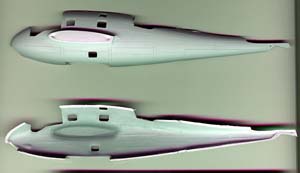


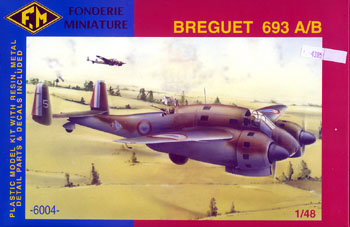 Fonderie
Miniatures 1/48 Breguet 693 A/B
Fonderie
Miniatures 1/48 Breguet 693 A/B
By John Lester
Introduction
The Breguet 693 was the culmination of a series of aircraft that were originally to be three place, twin engine fighters. Potez won the contract with their 630 series aircraft, but the Breguet company continued developing their design as a multi-role aircraft. Though the design of the aircraft started in 1935, the first prototype did not fly until 1938. Breguet could not get the necessary Hispano-Suiza engines until then (the company had not been nationalized with the rest of the French aviation industry, and as a result had low priority for things like engines). Too bad, as the prototype had better performance than the Potez 630. Though the prototype went back for modifications, French authorities were sufficiently impressed that they ordered 100 aircraft as two-place attack bombers.
Considerable thought had been given to armament for the attack role that could be used against ground and aerial targets. This comprised one 20mm cannon and two 7.5mm machine-guns, which could be depressed 15 degrees for strafing. Rear defense was provided by a 7.5 mm machine-gun on a flexible mount, plus another in the belly firing aft and down. The prototype's navigator station was deleted to provide space for a bomb bay holding up to 400kg of bombs. Later versions had two additional 7.5mm MGs installed, one each in the rear of the engine nacelles firing aft.
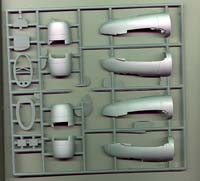 |
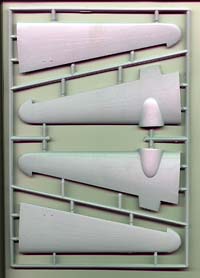 |
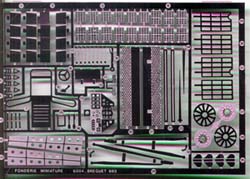 |
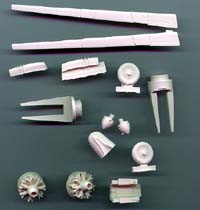 |
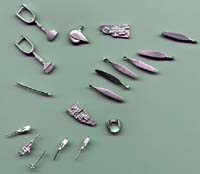 |
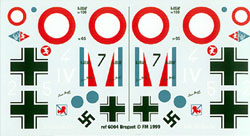 |
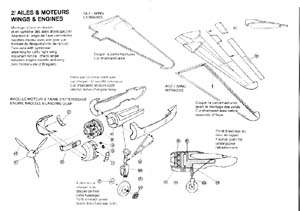 |
The first production Bre 691 flew in May 1939, with squadron delivery starting in October. Experience with the new aircraft proved the H-S powerplant unreliable, so later production aircraft were modified to accept two Gnome-Rhone 14M-6/7 engines. This version, the Bre 693, became the production standard, and was virtually identical to earlier aircraft (except for the engines). Eventually, 234 Bre 693's were built, along with 50 or so Bre 695's, which were identical to the preceding aircraft accept for powerplant (in this case, two Pratt & Whitney Twin Wasp Juniors).
The Bre 693's combat service was short and inauspicious. The first raid saw 10 of 11 aircraft lost. In subsequent operations, the aircraft proved relatively effective if provided with adequate escort. Still, by the Armistice, over 50% of the 106 aircraft delivered to the Armee de l'Air were destroyed. Two Vichy groupes continued to use the aircraft after the Armistice, but in November 1940, the Nazis confiscated all remaining airframes. Many were transferred to Italy for use as trainers.
The Kit
FM is a French company of which I've heard very little, except that their previous releases do not equal the level of detail and accuracy of Classic Airframes (MB152/MB155) or HiTech (D510). But when I saw that they had released a Bre 693, my favorite French aircraft, in my scale - well, let's just say caution and budget were thrown to the winds.
I was not disappointed upon opening the box .. but I wasn't awed either. The main pieces (fuselage, wings, tail, engine nacelles) come on three sprues of medium grey plastic reminiscent of the Mirage PZL- 37. The plastic is relatively soft and has a slightly pebbly texture (like the Los) which should disappear under a coat of paint. Surface detailing consists of engraved panel lines. The engraving is deeper and more pronounced than on Classic Airframes or Edward kits, but not nearly as bad as that plowed on to Matchbox kits. Test fitting the major parts indicates the engraved lines actually meet up across part halves, a good thing. There is some flash and a sinkhole or two, but no major molding flaws are evident.
Also included are white metal, resin and photoetched steel parts. The white metal parts include separate propeller blades, landing gear struts, tailwheel, guns and a fuselage bulkhead. Aside from the guns, the parts look fine, with no casting defects. The machine guns look small in comparison with other weapons in 1/48, and the detail isn't great. They are prime candidates for aftermarket parts .. if any aftermarket French 7.5mm MGs exist.
The resin parts are mainly for the engine/nacelle area, though wheels and ailerons are also included. The resin is the hard, grainy stuff typical of French kits. The pieces are also well cast, with no flash, bubbles or voids to mar the detail. Interestingly, resin plugs are provided for the inside of the nacelles, on which the landing gear and engines are mounted.
The photoetch sheet covers the interior, with parts for sidewalls, bomb bay, and various cockpit details. Rounding out the parts is a clear vacuformed sheet with one set of transparencies.
The decals are crisply printed and perfectly registered. They look admirably thin. I have no experience with FM decals, so I can't say how easy to use they will be.
Two large sheets, printed back and front, make up the instructions and paint guide. The instructions, which consist of exploded diagrams with French and English call outs, appear adequate. The paint guide has a short history of the aircraft, and drawings of seven different aircraft (two Vichy, four pre-Armistice and one in Luftwaffe markings) for which decals are provided. Paint call outs are given in FS numbers and French names (except for the interior colors, which are in French - and just what is a "Logement de volet" anyway?)
Areas of Concern
Like most limited run kits, this one has no locating pins or other alignment aids. This should not be a problem for the careful modeler - when assembling the big pieces. However, care and constant test fitting will be required to get the interior pieces properly positioned, as there are no guides of any sort for those either.
All major parts fit together with butt joins. This will make getting the correct dihedral on the wings tricky. I'll also probably reinforce the wing join with wires pinning the pieces together. There are several pieces where some cutting will be needed to get a good fit - the canopy area and trailing edge of wings being the most prominent. Again, care will be needed to get the fit right here. Installing the vaious fuselage windows will be .. interesting, as there are no ledges or other placement aids. There's nothing worse than having a window pop out and rattle around the inside after you've completed your masterpiece. And, with just one set of transparencies, there is no room for error.
Accuracy and detail throughout look good, with the possible exception of the main gear wells. There's no detail in them, and no gear doors either (though to be honest, I don't know yet whether there was gear doors, or if it really was just a cut out. In either case, the inside of the wheel wells could stand some extra detailing. I'll probably also add brake lines to the main gear and ignition harness to the engines (standard modifications for me).
CONCLUSION
All-in-all, this does not appear to be a bad kit. It's not one I'd recommend to folks without a few limited run models under their belt (that's built, not stuffed in the closet!), but if the subject interests you, go for it.

Previous: Contents


